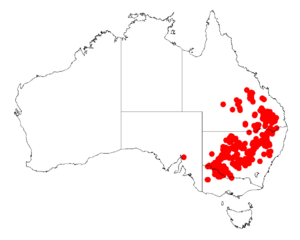Acacia melvillei facts for kids
Quick facts for kids Yarran |
|
|---|---|
| Scientific classification | |
| Genus: |
Acacia
|
| Species: |
melvillei
|
 |
|
| Occurrence data from AVH | |
The Yarran (scientific name: Acacia melvillei) is a special type of shrub or small tree. It belongs to the Acacia family, which is also known as wattles. This plant is found only in south-eastern Australia.
Contents
About the Yarran Plant
The Yarran can grow quite tall, sometimes reaching up to 15 meters (about 50 feet). Its small branches are smooth, meaning they don't have any hairs.
Leaves and Flowers
Like many Acacia plants, the Yarran doesn't have true leaves. Instead, it has what are called phyllodes. These are flattened leaf stems that act like leaves.
- The phyllodes are always green and feel a bit leathery.
- They are shaped like a narrow oval or rectangle.
- They are usually straight and measure about 5 to 10 centimeters (2 to 4 inches) long.
- Their width can be from 5 to 25 millimeters (about 0.2 to 1 inch).
- You can see many thin lines, called nerves, on the phyllodes. Some of these lines are clearer than others.
Yarran plants bloom between August and November. Their flowers grow in small groups of three to five.
- These groups are found along a short stem, usually 1 to 6 millimeters long.
- The flower heads are round, like little balls, and are about 4 to 6 millimeters across.
- Each flower head is packed with 30 to 50 bright yellow flowers.
Seed Pods
After the flowers bloom, flat, papery seed pods start to form.
- These pods are mostly straight along their sides.
- They might look a bit pinched in places where the seeds are.
- The pods can grow up to 9 centimeters (about 3.5 inches) long and 7 to 10 millimeters (about 0.3 to 0.4 inches) wide.
- They have a few scattered hairs on them.
How Yarran Got Its Name
The Yarran plant was first officially described in 1978 by a botanist named Leslie Pedley. He wrote about it in a science journal called Austrobaileya.
- For a short time in 1987, it was called Racosperma melvillei.
- But in 2001, it was moved back into the Acacia group.
The second part of its scientific name, melvillei, was chosen to honor Ronald Melville. He was a botanist who worked at the famous Kew Royal Botanic Gardens in England. The Yarran looks a lot like another plant called Acacia homalophylla. Scientists also think it can sometimes mix with Acacia loderi to form hybrids, which are like mixed-up versions of the two plants.
Where Yarran Grows
The Yarran plant is found in a large area of south-eastern Australia.
- Its range starts in Queensland, near a town called Clermont.
- It stretches south through central New South Wales.
- It reaches into the northern parts of Victoria, as far south as Mildura and Kerang.
Yarran often grows in areas with mixed open woodlands. It can be found in different types of soil, including loam, clay, and sandy soils. In some parts of New South Wales, especially in the Riverina and Murray-Darling areas, the Yarran forms special shrublands. These shrublands are considered endangered.
- Sometimes, Yarran grows in large groups by itself.
- Other times, it grows with other tall shrubs or trees like Acacia loderi, Alectryon oleifolius, Casuarina pauper, and Myoporum platycarpum.
- Below the main trees and shrubs, there's usually a layer of smaller shrubs.
- The ground layer, which has grasses, can be different in how much it grows.
Images for kids


